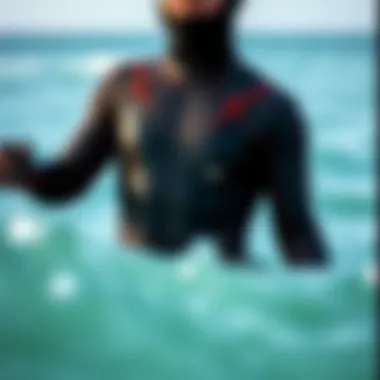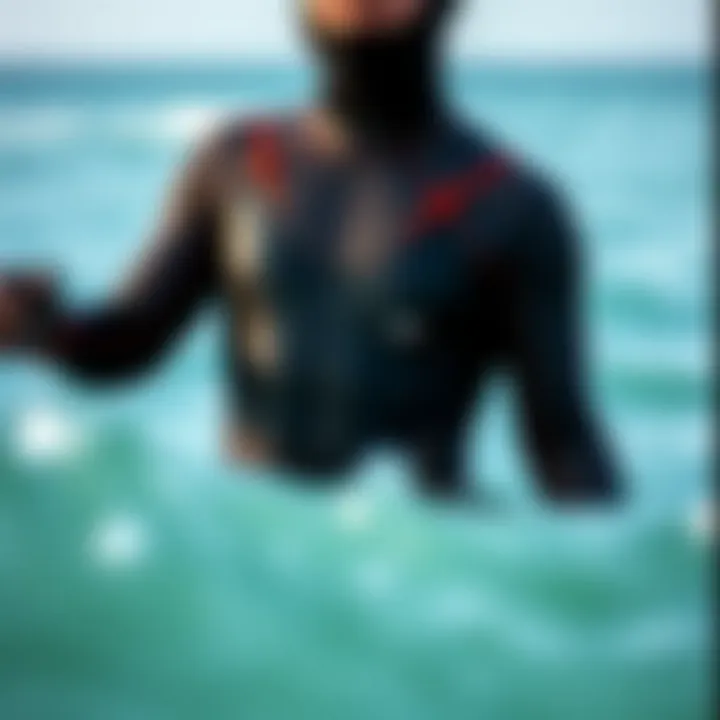The Ultimate Guide to the 5 3 Wetsuit for Kiteboarding


Intro
Kiteboarding, a thrilling blend of surfing and kiting, requires the right gear to make the most of each ride. Among the essential items in this sport is the wetsuit. This guide aims to equip kiteboarders with a comprehensive understanding of the 5 3 wetsuit, exploring its specifications, benefits, and practical applications.
The thickness of a wetsuit plays a pivotal role, especially in varying water conditions. A 5 3 wetsuit – measuring 5mm thick in the torso area and 3mm in the limbs – strikes a balance. It provides warmth while allowing flexibility, ideal for kiteboarders navigating cooler waters.
Whether you’re just starting or are a seasoned pro, the nuances of wetsuit selection can influence your performance, comfort, and enjoyment on the water. Here, we delve into every aspect of the 5 3 wetsuit, ensuring you are well-prepared for your next adventure!
Equipment Insights
Latest Gear Reviews
When considering a wetsuit, the brand and model can significantly impact your experience. Not every wetsuit is created equal, and some excel in specific conditions. Look out for vast brands like Rip Curl, O'Neill, and Quiksilver, which offer high-quality 5 3 wetsuits geared towards kiteboarding.
These wetsuits often come equipped with features such as:
- Glued and blind-stitched seams: These prevent water from seeping in, enhancing warmth.
- Flexible neoprene: This material allows for greater freedom of movement, critical for executing those tricky maneuvers.
- Wrist and ankle seals: Reducing water entry helps maintain body temperature during long sessions.
Additionally, online reviews can be enlightening. Websites like Reddit or specific kiteboarding forums provide personal experiences that help to weigh your options thoroughly.
Essential Gear Maintenance
Caring for your wetsuit prolongs its lifespan. Here's some tips to help you keep your gear in top condition:
- Rinse after use: Always rinse your wetsuit with fresh water to remove salt and sand.
- Dry it properly: Avoid hanging it in direct sunlight. Instead, lay it flat or hang it in a shaded area to prevent damage.
- Store it correctly: Maintain its shape by hanging it on a wide hanger specially designed for wetsuits.
Whether it's replacing a worn zipper or ensuring the seams are intact, regular maintenance keeps your suit functional and comfortable.
"A good wetsuit is like an old friend; the better you care for it, the longer it stays by your side!"
Keeping these factors in mind not only optimizes performance but also enhances your overall kiteboarding experience, making each session a memorable one.
Technique Exploration
Beginner Techniques
For those new to kiteboarding, mastering the basics while wearing a wetsuit requires specific techniques. It’s essential to familiarize yourself with how your wetsuit feels when navigating through the water. Keep these tips in mind:
- Balance is Key: Ensure your center of gravity remains low; this helps maintain stability on the board.
- Control the Kite: Learning to manage your kite while adjusting to the wetsuit's feel is crucial. Start with gentle movements before attempting aggressive maneuvers.
- Practice Safety: Always wear a leash and harness to prevent losing your board in choppy waters.
Advanced Maneuvers
For those looking to elevate their skills further, here are some maneuvers to consider:
- Jumping: Timing is everything. Combine the kite's lift with a strong pop from your legs.
- Transitions: Seamlessly changing direction can give you more flow on your ride, requiring precise pressure on your edges.
- Tricks: Once comfortable, try advanced tricks like spins and flips, which require both skill in kite control and familiarity with your wetsuit's contribution to mobility.
By cultivating these techniques, learners and veterans alike can maximize their time on the water while staying comfortable and agile in their 5 3 wetsuits.
Being well-informed about the gear you choose not only enhances personal performance but contributes greatly to the kiteboarding community as a whole. With knowledge in hand, gear up, hit the waves, and let the wind propel you to new heights.
Prolusion to the Wetsuit
Kiteboarding can be a mesmerizing experience, but it often comes with its fair share of chills, literally. Enter the 5 3 wetsuit—a key piece of gear that can transform your ride from brisk to comfortable. Understanding the thickness and materials behind the 5 3 wetsuit is crucial. In this article, we dive into the specifics of this wetsuit, shedding light on its beneficial attributes while also keeping an eye on aspects that kiteboarders should not overlook.
Understanding Wetsuit Thickness and Material
The term "5 3" refers to the thickness of the neoprene used in the wetsuit. Here’s how it breaks down: the first number, 5mm, typically covers the torso, while the second number, 3mm, is used for the limbs. This difference in thickness is designed to balance insulation and flexibility.
Neoprene, the material most wetsuits are made from, is a type of synthetic rubber known for its insulation properties. It keeps you warm in cooler waters by trapping a layer of water against your skin, which warms up to your body temperature. It's akin to wearing a cozy blanket made out of thick rubber, protecting you from the cutting chill of the ocean.
However, not all neoprene is created equal. High-quality wetsuits may use limestone-based neoprene, which is lighter and offers better flexibility compared to petroleum-based alternatives. As you slide into a 5 3 wetsuit, notice how the fabric feels against your skin—this is indicative of both comfort and freedom of movement.
Essential Features of the Wetsuit
When selecting a 5 3 wetsuit, you should keep your eyes peeled for a variety of essential features that cater specifically to kiteboarders. First off, consider the cut of the wetsuit. Many models come with ergonomic designs that allow for ease of motion—vital for executing tricks and maneuvers.
Additionally, features like reinforced seams, commonly known as blind or flatlock seams, are crucial for durability. These types help prevent water from seeping into your suit, keeping you warm and dry while you glide over the waves. Some wetsuits also come with added elements like ankle zippers or built-in hoods, designed for those extra brisk kiteboarding days.
Moreover, ease of putting on or taking off a wetsuit cannot be understated. Look for suits with a back zip or front zip entry, which often provide a comfortable fit without being excessively restrictive.


In summary, knowing about the composition and notable features of the 5 3 wetsuit can significantly enhance your kiteboarding experience. So, don’t just jump into any old suit—be discerning and select one that suits your specific needs while providing both comfort and performance.
Benefits of a Wetsuit for Kiteboarding
When it comes to kiteboarding, a few things matter just as much as the right gear. Among those, the 5 3 wetsuit stands out for its unique advantages, making it a choice that many kiteboarders flock to. This section delves into the various benefits of using a 5 3 wetsuit and how its features contribute to an improved kiteboarding experience. Understanding these aspects is crucial, whether you are a seasoned kiteboarder or just starting out.
Temperature Regulation
A major perk of the 5 3 wetsuit is its ability to regulate temperature effectively. Kiteboarding often takes you through chilly waters, especially in the early mornings or late evenings. With a 5 mm thickness in the torso and 3 mm in the limbs, this wetsuit strikes a balance between warmth and mobility. This combination helps maintain core body temperature during prolonged exposure to cold, wet conditions, allowing you to focus more on enjoying the ride rather than shivering in discomfort.
It's essential to note that a wetsuit's insulation works not just through thickness but also material. Most 5 3 wetsuits use neoprene, which traps air and minimizes heat loss. So when the wind bites on an autumn day, this wetsuit keeps the chill at bay, making your sessions longer and more enjoyable.
Mobility and Flexibility
Another key element of the 5 3 wetsuit is its mobility and flexibility. As a kiteboarder, you don't want to feel restricted while you cut through the waves or execute that perfectly timed trick. The wetsuit is designed to fit snugly without being too tight, enabling a full range of motion.
The 3 mm panels in the arms and legs provide greater flexibility, allowing for a comfortable range of motion without sacrificing protection. This is particularly noticeable while you are landing jumps or navigating tricky turns. Pros often stress that the right wetsuit should feel like a second skin, and a well-made 5 3 does just that.
Durability and Resistance to Wear
Lastly, let's talk about durability and resistance to wear. Kiteboarding often involves rough conditions that can quickly damage inferior gear. The robust construction of a quality 5 3 wetsuit makes it resistant to tears, abrasions, and UV damage. By investing in this wetsuit, you are opting for a piece of gear that can withstand the daily grind on the water as well as specks of sand that can sneak into your rig.
Features like reinforced seams and robust zippers also add to the wetsuit’s longevity. Regular maintenance, alongside this durability, ensures that your 5 3 roup remains functional through many seasons of kiteboarding. That's why kiteboarders often suggest looking beyond the initial price and considering the long-term investment.
“There's nothing worse than feeling your suit give out right when you're about to nail a trick.”
In summary, the 5 3 wetsuit is a powerhouse of temperature regulation, flexibility, and durability, making it an essential part of any kiteboarder's gear collection. Understanding these benefits helps you appreciate the significantly improved experience one can have in the water.
Choosing the Right Wetsuit Size and Fit
When it comes to kiteboarding, the right wetsuit size and fit is not merely a matter of comfort; it can make or break your experience on the water. A poorly fitting wetsuit can lead to unnecessary restrictions in movement, uncomfortable chafing, and can even impact your thermal protection. Conversely, a well-fitting wetsuit enhances not only your overall performance but also your enjoyment of the sport. It’s vital for you to invest time in finding the right size and fitting style that accommodates your body shape and riding style.
Identifying Your Measurements
To find the right wetsuit, start with understanding your measurements. This isn’t just a casual guess; accurate measurements can save you frustration and money.
- Height: Stand straight and measure from the top of your head to your feet. This will determine if you need a short, regular, or tall wetsuit.
- Weight: Your weight can impact the thickness of the wetsuit you select. Lighter folks might opt for a thinner suit, while a heavier build may require something with a bit more insulation.
- Chest and Waist: Measure around the fullest part of your chest and your natural waist. These measurements are crucial since they directly influence the suit’s tightness around your torso.
- Inseam and Outside Leg: The length of your legs matters too. Measures from the crotch to the ankle, plus the outside of the leg will guide you to ensure the wetsuit isn’t too short or unnecessarily long.
An important tip—many brands provide size charts, so don’t neglect to consult those! Even more so, if you happen to fall between sizes, it’s generally better to err on the side of a tighter fit. A wetsuit expands in water and looser suits can leave room for water to rush in and make you feel cold.
Understanding Fit Types: Tight vs. Loose
This brings us to the fit types: tight versus loose. You might think it’s straightforward, but each choice has its own implications for a kiteboarder.
- Tight Fit:
- Loose Fit:
- A tighter fit maximizes warmth and minimizes water entry. Wetsuits that hug your body create a snug barrier against cold water, thereby increasing thermal retention. Additionally, a form-fitting suit can significantly improve hydrodynamics allowing you to glide more effortlessly across the surface. Just be cautious; if it's too tight, it may restrict circulation or be uncomfortable over long periods.
- On the flip side, a loose fit can provide ease of movement, which is tempting, especially when performing tricks. However, if it’s excessively loose, it allows for water to seep in, leading to a drastic drop in warmth. Having the bum hang too low can slow you down or, worse, become a distraction.
Finding balance is key. Most kiteboarders prefer a fit that offers just enough snugness without causing discomfort. Using a wetsuit for kiteboarding shouldn't feel like strapping into a vice; rather, it should feel like a second skin that lets you focus entirely on the ride.
"The right wetsuit makes a world of difference—it's your armor against the elements."
When to Use a Wetsuit
Selecting the right time to don a 5 3 wetsuit is more than just a matter of personal comfort; it deeply relates to both safety and performance in kiteboarding. The key to maximizing your kiteboarding experience lies in understanding the seasonality and environmental conditions that dictate when this thickness is most appropriate. Let's delve into the specific elements that help determine the right timing for using a 5 3 wetsuit, and how these choices affect your ride.
Seasonal Considerations
When it comes to seasonal considerations, a 5 3 wetsuit shines particularly during the transitional months of spring and fall. These periods often present unpredictable weather and varying water temperatures, warranting attentiveness to suit thickness. Using a 5 3 wetsuit in these months can be a lifesaver. Here are a few vital points:
- Temperature Range: 5 3 wetsuits are designed to function well in water temperatures ranging from roughly 50°F to 65°F. If you’re planning your kiteboarding session in climates where the temperature fluctuates between these numbers, opting for a 5 3 wetsuit is wise.
- Weather Variability: Spring and fall can throw surprises at you. One minute it’s sunny, and the next, clouds roll in. A thicker wetsuit offers that extra layer of protection when cold winds blow. Thus, you can confidently extend your session even when conditions change.
- Local Trends: Familiarize yourself with local kiteboarding communities or online forums. Activist groups seem to regularly share insights about optimal seasonal gear choices. What works for one spot might be different at another. So, local knowledge can be invaluable.
"Every kiteboarder should consider the local seasonality and variability. The last thing you want is to be caught in chilly waters without the right gear!"
Conditions Affecting Wetsuit Choice
Besides the seasons, specific environmental conditions play a major role in deciding whether a 5 3 wetsuit is the right fit for the day. Understanding these can dramatically improve your kiteboarding experience:


- Wind Conditions: High winds can lead to increased heat loss from your body. A 5 3 wetsuit can provide additional thermal insulation when the wind chill factor comes into play, so you remain comfortable while navigating choppy waters.
- Duration of Activity: If you're planning on long sessions out in the water, the thickness of the wetsuit becomes even more critical. The cozy embrace of a 5 3 wetsuit can help mitigate the risk of hypothermia during extended exposure.
- Physical Activity Level: If you know you’ll be engaging in intense kiteboarding maneuvers, your body generates heat. A 5 3 wetsuit strikes a balance; it helps insulate without causing overheating, which is crucial for retaining optimal performance.
- Water and Air Temperature: Always check the local forecast. If water temperatures dip below 55°F, wearing a 5 3 wetsuit adds a layer of warmth that can be very necessary. Conversely, if it’s an unseasonably warm day, you might find yourself feeling overly warm as you ride.
The decision of when to wear a 5 3 wetsuit involves a mixture of elements: seasonality, your local weather patterns, and specific riding conditions. Caring about these factors ultimately leads to not just a more comfortable experience but a safer and more enjoyable one.
Care and Maintenance of Your Wetsuit
Taking care of your wetsuit is crucial, especially when it comes to kiteboarding. The right care not only extends the lifespan of your wetsuit but also keeps you performing at your best on the water. Wave after wave, your wetsuit is your shield against the elements, so treating it with respect is only fair. Improper care can lead to wear and tear much sooner than anticipated, affecting both comfort and functionality.
It’s essential to establish a care routine that includes proper washing and storage. By doing so, you write a ticket to longevity for your wetsuit. Let's dive into the nuts and bolts of maintaining your gear, so you're not left high and dry.
Washing Techniques for Longevity
After each kiteboarding session, your wetsuit becomes a collection of salt, sand, and whatever else is lurking in the water. Here’s how to give it the gentle cleaning it deserves:
- Rinse Immediately: As soon as you step out of the water, rinse your wetsuit thoroughly with fresh water. This simple act can prevent salt and dirt from installing a permanent residency on your suit.
- Turn it Inside Out: When washing at home, turn your wetsuit inside out to clean the inner side where sweat and other toxins might gather more intensely. This method helps avoid unpleasant odors and bacteria buildup.
- Gentle Soap Only: Use a mild detergent specifically designed for neoprene. Regular laundry detergent can be too harsh and strip away essential oils that keep the material flexible.
- Cold Water Is Key: When it comes to washing, stick to cool or lukewarm water. Hot water can damage the wetsuit's structure, reducing its insulating properties.
- Hang Dry: After washing, hang your wetsuit to dry in a shaded area, avoiding direct sunlight that can break down the neoprene.
By integrating these washing techniques into your routine, your wetsuit will remain in peak condition, extending its life through countless kiteboarding adventures.
Proper Storage Solutions
How you store your wetsuit can make or break its durability. Storing it correctly is often overlooked, but it plays a pivotal role in keeping your wetsuit ready for action. Here are some practical tips:
- Avoid Folding: Never fold your wetsuit. Instead, hang it on a wide hanger that can support its weight. Folds can cause permanent creases and compromise insulating capabilities.
- Use a Wetsuit Bag: When transporting or storing for an extended period, use a breathable wetsuit bag. This prevents dust and helps maintain its shape as well.
- Store in a Cool Place: Keep your wetsuit in a cool, dark area away from direct sunlight and heat sources—these can warp the material over time.
- Keep Away From Pests: Ensure that your storage area is free from pests that might nibble at the fabric. A sealed container can help keep unwanted guests at bay.
Proper storage is just as critical as washing; neglecting it can lead to premature wear, turning your beloved wetsuit into a relic of the past.
By following these care and maintenance tips, you not only enhance the longevity of your wetsuit but also ensure that it's ready for your next kiteboarding session. A well-cared-for wetsuit will provide comfort, warmth, and flexibility—everything a kiteboarder needs to ride the waves.
Comparative Analysis with Other Wetsuit Thicknesses
When it comes to selecting the right wetsuit for kiteboarding, understanding the comparative elements of different thicknesses can be the difference between a comfortable session on the water and one that leaves you shivering. The 5 3 wetsuit strikes a specific balance, serving kiteboarders well in a range of conditions. It's vital to comprehensively evaluate how it stacks up against other thicknesses like the 4 3 and 6 5 wetsuits. This analysis encompasses not just comfort, but also performance and flexibility, which are crucial factors for kiteboarding enthusiasts.
Comparing Wetsuit to Wetsuit: Pros and Cons
Both the 5 3 and 4 3 wetsuits are designed for cooler waters, but they cater to slightly different conditions and preferences.
Pros of Wetsuit:
- Warmer in Chilly Conditions: The extra thickness of 5mm in the core area provides better insulation, keeping you warm during extended periods on the water.
- Ideal for Varied Temperatures: This wetsuit is great for those transitional months, when temperatures vary significantly throughout the day.
Cons of Wetsuit:
- Less Flexibility: While still designed for movement, the added thickness can restrict flexibility slightly compared to a 4 3 wetsuit, which can make performing tricks feel a bit more cumbersome.
- Possible Overheating: On warmer days or in warmer waters, the 5 3 might cause you to overheat more quickly than its thinner counterpart.
Pros of Wetsuit:
- Greater Flexibility: A thinner fit can allow for better mobility, crucial when executing complex maneuvers.
- Cooler Water Use: Perfect for those who are frequently in slightly warmer waters or prefer a more versatile piece of gear for varied conditions.
Cons of Wetsuit:
- Reduced Insulation: In really cold waters, this wetsuit may fail to provide the warmth needed for comfort over long sessions.
- Seasonal Limitations: Best suited for specific seasons, while the 5 3 can cross over into both spring and fall comfortably.
Ultimately, the choice between a 5 3 and a 4 3 wetsuit hinges on personal comfort and the typical conditions in which you feel at home.
Evaluating Wetsuit Usage Scenarios
The 6 5 wetsuit on the other hand, represents a whole new ball game. Its thicker style comes into play when temperatures drop further. Here are a few scenarios to consider when it comes to the 6 5.
- Extremely Cold Climates: If you find yourself kiteboarding in near-freezing temperatures or during harsh winters, this suit is designed to keep the bone-chilling water at bay.
- Long Sessions: For those marathon kiteboarding sessions, where time on water is excessive, the added insulation can be beneficial to withstand even the most brutal conditions. The trade-off? The flexibility takes a bit of a hit, but it’s a small price to pay for keeping warm.
Epilogue to Analysis
In the grand scheme, the choice of wetsuit thickness doesn't only determine your comfort level—it impacts your overall experience, performance, and longevity out on the water. Thus, understanding how the 5 3 wetsuit interacts with alternatives like the 4 3 and the 6 5 can provide kiteboarders with a significant edge. Whether you're looking to carve the waves in chilly seasons or endure long sessions in cooler waters, having a comprehensive view of these different thicknesses aids in making an informed decision that fits your specific needs.
"The right wetsuit is not just gear; it can be your lifeline during those chilly adventures!"
For more information on wetsuit specifications, check this resource.
For community feedback on various wetsuits, consider visiting platforms like Reddit.


This comparative analysis serves as an essential foundation to guide kiteboarders in their quest for the ideal wetsuit.
Innovations in Wetsuit Technology
The world of kiteboarding, much like other action sports, is perpetually evolving. As kiteboarders seek to make the most of their time on the water, advancements in wetsuit technology are becoming increasingly critical. The 5 3 wetsuit isn't just a piece of gear. It's a blend of science and innovation, designed to enhance comfort, functionality, and performance on the waves. As kiteboarders navigate their ideal conditions, the technology behind their wetsuit can truly make the difference between a great session and a mediocre one.
Advancements in Insulation Materials
Gone are the days when neoprene was the only option. Modern wetsuits are now made with high-tech insulation materials that have revolutionized the water sports industry. Companies are utilizing materials like Eco-Friendly Neoprene, which reduces carbon footprints while delivering superior warmth. Moreover, brands are experimenting with heat-retaining technologies which trap warmth without adding bulk.
- Thermal Linings: Recent advancements have led to thinner thermal linings that fit snugly against the skin. They help maintain core temperature without sacrificing mobility.
- Graphene-Infused Foam: A new kid on the block, graphene-infused foam, is known for its durability and heat retention, making it an excellent choice for cold-weather kiteboarding.
- Superstretch Neoprene: Flexibility is enhanced through the use of superstretch neoprene sections. This innovation allows for a greater range of motion, which is crucial when performing tricks and maneuvers.
Incorporating these materials yields a wetsuit that not only keeps you warm but also allows for greater agility, which kiteboarding demands.
Enhanced Sealing Systems
In the pursuit of excellence, every detail counts. Enhanced sealing systems play a fundamental role in maintaining warmth and reducing water entry. The evolution of these systems has led to significant improvements in wetsuit performance.
- Glued and Blind Stitched Seams: These methods have been around for a while but have undergone refinements to improve durability and water resistance. This helps kiteboarders stay warm, prolonging sessions without the chilling effects of water infiltration.
- Taped Seams: Taped seams are another level of technology, offering a water-tight seal that is especially favorable for colder waters. It’s like wearing a barrier against the elements.
- Zipper Innovations: The introduction of front zippers with internal watertight seals makes it easier to don and doff while still offering a snug fit that minimizes water entry.
Enhancing sealing systems not only aids in keeping water out but also contributes to a more comfortable experience overall. Kiteboarders can focus on their performance rather than worrying about the chilling effects of water seeping in through less-than-optimal seams.
"The right technology in a wetsuit can be a game-changer. Innovations aren't just about warmth; they're about pushing the boundaries of performance."
As kiteboarding enthusiasts evaluate their gear, understanding these innovations can open doors to better experiences on the water. Overall, the continuous advancements in wetsuit technology promise a future filled with even greater possibilities for kiteboarders, where comfort meets cutting-edge science.
Feedback from Kiteboarding Enthusiasts
When it comes to purchasing a wetsuit, particularly the 5 3 wetsuit, the voices of those who are already navigating the waves can be invaluable. User feedback provides insights into the real-world performance of this gear, bridging the gap between what manufacturers advertise and what kiteboarders truly experience. Understanding this topic is crucial for both newcomers and seasoned riders looking to enhance their gear selection.
User Experiences with the Wetsuit
Diverse Conditions, Varied Opinions
Every kiteboarder's journey is unique, often shaped by local conditions and personal preferences. Positive experiences tend to revolve around thermal comfort, with many enthusiasts highlighting how the 5 3 suit effectively retains warmth even in chilly waters. Riders often note that the balance between buoyancy and flexibility in these wetsuits allows for smooth transitions and fluid movements.
However, some users report that fit can be tricky. A snug suit is essential, but for individuals with larger frames, finding the right size might lead to discomfort around the shoulders or neck area. It's important to factor in these variances when considering user feedback. As one kiteboarder on a popular forum stated, > "The warmth of my 5 3 is fantastic, but sometimes it feels like I'm fighting my suit instead of riding the waves!"
Recommendations from Professionals
Feedback from industry professionals or seasoned instructors in the kiteboarding community presents another layer of wisdom. Many professionals recommend the 5 3 wetsuit for its versatility in varying water temperatures and conditions. They often emphasize the importance of quality over quantity, urging kiteboarders to invest in a well-constructed wetsuit that withstands wear and tear over time.
Things to consider based on professional insights include:
- Material Quality: Look for neoprene that offers a great mix of durability and comfort. High-quality neoprene helps maintain warmth and lasts through regular use.
- Seams and Stitching: Professionals often stress the significance of sealed seams in preventing water from seeping in. Whether glued, blind-stitched, or liquid taped, seam integrity matters.
- Mobility: Advanced riders need suits that allow for a full range of motion. Professionals advise testing various wetsuits to ensure they don’t restrict movement during high-performance maneuvers.
Kiteboarding professionals tend to agree that while budget considerations play a role, investing more upfront often pays off in comfort and longevity. They commonly suggest that enthusiasts familiarize themselves with the specific brands and models that have proven reliable within the community. Consequently, recommendations often spawn lively discussions on platforms like Reddit or dedicated Facebook groups focused on kiteboarding.
In sum, understanding feedback from users and professionals helps aspiring kiteboarders navigate the nuances of choosing the right 5 3 wetsuit. This knowledge, gathered through shared experiences, helps foster a community where informed decisions lead to better kiteboarding adventures.
End: The Role of the Wetsuit in Kiteboarding
In the realm of kiteboarding, the 5 3 wetsuit stands as a central piece of gear that directly influences performance and comfort. This guide has delved into the nuances of this particular wetsuit thickness, revealing its significant role in the rider’s experience on the water. The importance of high-quality materials and thoughtful design considerations cannot be overstated here. Without the right wetsuit, kiteboarders may find themselves battling the elements rather than enjoying their time on the water. Thus, the 5 3 wetsuit emerges as an essential ally against both chilly temperatures and potential injuries, retaining warmth while allowing ample mobility.
Several key points have been emphasized throughout this article. Kiteboarders must consider the climatic conditions where they ride, as this will dictate the necessity and functionality of the 5 3 wetsuit. Moreover, understanding the balance between comfort and protection is crucial. As kiteboarding often involves various water conditions and climatic changes, choosing the right thickness ensures that riders can focus on their skill without the distraction of discomfort or excessive cold.
"A proper wetsuit is not just about what keeps you warm; it’s about what enables you to perform at your best."
In summary, the right wetsuit enhances not just safety, but also overall enjoyment. By being attuned to the features and specifications of the 5 3 wetsuit, kiteboarders can tailor their gear to their specific needs. Understanding the intricacies of insulation materials and flexibility options can make a world of difference on the water.
Summarizing Key Points
The discussion surrounding the 5 3 wetsuit encapsulates several critical aspects:
- Temperature Regulation: Average water temperatures often fluctuate, and the 5 3 thickness provides an exceptional compromise between warmth and movement.
- Mobility and Flexibility: Many modern wetsuits feature materials that stretch, allowing kiteboarders to execute maneuvers without restrictions, which is paramount during intense sessions.
- Durability: The wear and tear from the ocean can be tough on gear. Investing in a 5 3 wetsuit designed for durability means fewer replacements and more time enjoying the ride.
- Fit and Comfort: Choosing the right fit is not just about sizing; it’s also about the feel of the suit in action. A well-fitted wetsuit can make it seem like a second skin, offering maximum agility.
- Care and Maintenance: Properly maintaining your wetsuit lengthens its lifecycle, saving costs in the long run and ensuring consistent performance.
These points encapsulate why the 5 3 wetsuit is not merely a purchase but an investment into a kiteboarder’s journey on water.
Final Thoughts on Wetsuit Selection
Selecting a wetsuit isn’t just a matter of picking a size off a rack. Instead, it requires a thoughtful approach, considering aspects like fit, seasonality, and personal performance goals. The 5 3 wetsuit occupies an essential role in the gear lineup for enthusiastic riders who want to maximize their experience, regardless of changing weather or water conditions.
Different kiteboarders will have varied preferences and needs. Some might prioritize insulation due to colder climes, while others may focus on lightness for extensive mobility. Learning to navigate through these considerations means taking the time to research and potentially try on various models.
Ultimately, a well-chosen wetsuit is like a trusty surfboard; it empowers riders to push their limits and explore new horizons. Therefore, when it comes to the 5 3 wetsuit, the right selection can lead to countless exhilarating sessions and triumphs out on the waves.
In closing, whether you are a novice kiteboarder or a seasoned veteran, understanding the nuances of wetsuit selection brings you one step closer to mastering your craft. Take the time to invest wisely, ensuring that your wetsuit complements your passion for the sport.







